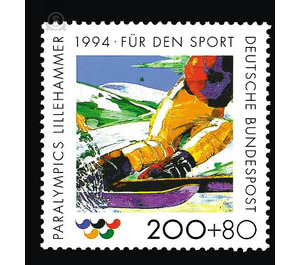sport aid - Germany / Federal Republic of Germany 1994 - 200 Pfennig
Theme: Post & Philately
| Country | Germany / Federal Republic of Germany |
| Issue Date | 1994 |
| Face Value | 200.00 |
| Color | multi-colored white |
| Perforation | K 13 3/4 |
| Printing Type | Multicolor offset printing |
| Stamp Type | Postage stamp |
| Item Type | Stamp |
| Chronological Issue Number | 1593 |
| Chronological Chapter | GER-BRD |
| SID | 914794 |
| In 24 Wishlists | |
For the 6th Winter Paralympics, which will be held from 10 to 20 March 1994 in Lillehammer (Norway), a record participation is emerging. 31 nations and over 1,000 participants, including around 700 athletes, will participate in the 1994 winter sports event for disabled people. The Winter Paralympics were first held in 1976 in Sweden. Norway hosts for the second time after 1980. In 1984 and 1988 the Winter Paralympics were held in Austria, 1992 in Tignes (France). The Paralympics are the realization of the Olympic idea and ideals in the disabled sport. Disabled people from all over the world show top athletic performance at the Paralympics, as well as the non-disabled at the Olympic Games. The Paralympics represent the highlight of their athlete's life for disabled athletes worldwide. The German Disabled Sports Federation will take part in the 6th Winter Paralympics in Lillehammer with a delegation of about 80 people, including 50 athletes. The athletes compete in nordic and alpine disciplines. The German Disabled Sports Federation with its 220,000 members supports the competitive sport and the Paralympic movement. The emblem for the Winter Paralympics in Lillehammer (the 5 waves in the colors blue, black, red, yellow and green) was used for the first time for the Paralympics in Seoul (Korea) in 1988, as well as for the Paralympics in Barcelona in 1992 Waves in "W-shape" symbolize the five oceans and the five continents of Asia, America (North and South), Europe, Africa and Oceania, moreover, that the disabled all over the world want to achieve harmony and unity through sport. The horizontal arrangement stands for equality and humanity. The wave itself is intended to symbolize the will and effort of the disabled to overcome the disability through activity. (Text: Stiftung Deutsche Sporthilfe, Frankfurt am Main)


